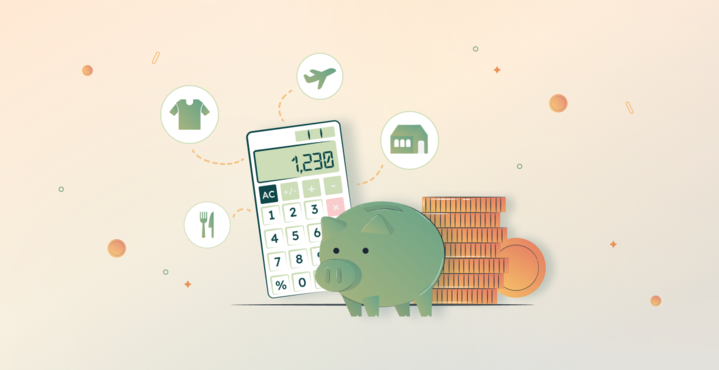Das Budget ist dein Plan, wie du und deine Familie Geld ausgeben und wofür. In diesem Blog-Beitrag erfährst du, wie du schlau budgetierst.
Was ist ein Budget und wozu dient es?
Dein Budget ist dein Gesamtplan über deine Einnahmen und Ausgaben in einem Zeitraum X (üblicherweise in einem Jahr). Die Basis des Familienbudgets ist das gesamte regelmässige Einkommen. Dem stellst du die verschiedenen Kostenpunkte gegenüber.
Ganz nach dem Motto «Ein Budget sagt uns, was wir uns nicht leisten können. Aber es kann uns nicht davon abhalten, es dennoch zu kaufen», kann dir ein Budget nur näher bringen, wie du deine Ausgaben gestalten solltest. Am Ende liegt es an dir, ob du diesen Plan tatsächlich befolgst.
Nimm dir dafür Zeit und stelle das Budget sauber auf. Ein Gesamtplan hilft dir, zu jedem Zeitpunkt genau zu wissen, wie viel Geld du wofür ausgeben kannst.
So oder so ist eine Budgetplanung ein wichtiger erster Schritt. Mach dir keine Sorgen, etwas falsch zu machen, sondern betrachte etwaige Fehleinschätzungen einfach als den ersten Schritt zur noch besseren Planung.
Warum überhaupt ein Budget führen?
Im Wesentlichen gibt es 2 Gründe, die für die Budgetierung sprechen:
- Bewusstsein: Nur wenn du weisst, wie es um deine Finanzen wirklich steht, kannst du die richtigen Entscheidungen treffen und Optimierungen vornehmen.
- Impulskontrolle: Hast du dir dein Budget schwarz auf weiss zurechtgelegt, wird dich das stark darin unterstützen, Impulskäufe zu vermeiden. Denke bei jeder Kaufentscheidung, ob sie in deinen Plan passt.
Richtiges Budgetieren – so geht’s
Eine Budgetierung erfordert eine möglichst realistische Einschätzung deiner geplanten Einnahmen, Erträge, Ausgaben und Kosten. Beachte folgendes:
- Plane nicht aus dem Bauch heraus, sondern erstelle dein Budget möglichst genau anhand von Lohnzetteln, Rechnungen, Kontoauszügen, Recherchen und Berechnungen.
- Unterscheide zwischen Fixkosten (z. B. Miete samt Nebenkosten, Leasing, Administration, Versicherungsprämien usw.) und variablen Kosten (z. B. Kleidung, Hygieneartikel, aber auch Lebensmittel). Letztere sind jene Kosten, die am ehesten explodieren. Sie eignen sich aber auch wunderbar dazu, Sparpotenziale zu entdecken.
- Erstelle jedes Jahr einen neuen Budgetplan. Viele machen dies am Jahresende für das kommende Kalenderjahr. Das Leben verändert sich nun mal laufend und so musst du auch dein Budget anpassen, z. B. wenn sich deine Familie vergrössert, dein Kind in die Schule kommt oder sich beruflich etwas verändert.
- Plane auch deine Spar-Ziele in dein Budget mit ein. Lege am besten einen monatlichen Betrag fest und stelle dir eine automatisierte Überweisung ein.
- Nutze Tools, um deine Budgetplanung übersichtlich zu gestalten. Es gibt dafür spezielle Apps, aber auch eine gut strukturierte Excel-Tabelle oder ein traditionelles Haushaltsbuch können hilfreich sein.
Für alle, die unseren monatlichen Newsletter abonnieren, senden wir gerne eine Excel-Vorlage mit einem Beispielbudget. Schreib uns einfach, wenn du Interesse hast!
Überlege dir verschiedene Budget-Szenarien
Neben dem jährlichen Budgetplan solltest du dir auch verschiedene Szenarien überlegen. Das kann gerade in unbeständigen Zeiten dabei helfen, bessere Entscheidungen zu treffen.
Zum Beispiel:
Szenario 1: Alles bleibt wie es ist
Hier kalkulierst du mit deinem aktuellen Einkommen und den laufenden Ausgaben. Du überprüfst, wie viel du am Monatsende sparen oder in Rücklagen legen kannst.
Szenario 2: Zusätzliche Kosten
Was passiert, wenn unerwartete Ausgaben wie eine Autoreparatur oder eine erhöhte Stromrechnung anfallen? Oder die Inflation plötzlich stark ansteigt? In diesem Szenario prüfst du, wie viel Puffer du brauchst, um solche Ausgaben abzufedern, ohne deine Ersparnisse zu stark zu belasten.
Szenario 3: Einkommen sinkt
Stell dir vor, dass dein Einkommen um 20 % sinkt – z. B. durch Kurzarbeit oder Jobwechsel. In diesem Szenario planst du, welche Ausgaben du kürzen könntest, um weiterhin deine Fixkosten zu decken und Rücklagen zu bilden.
Viel Erfolg beim Budgetieren! Falls du dazu noch eine Frage hast, kontaktiere uns gerne.
Sobald du dein Budget gemeistert hast, kannst du dir überlegen, wie viel zum Sparen für dein Kind übrig bleibt. Hier sind ein paar Orientierungspunkte rund um das Thema Sparen für dein Kind.





